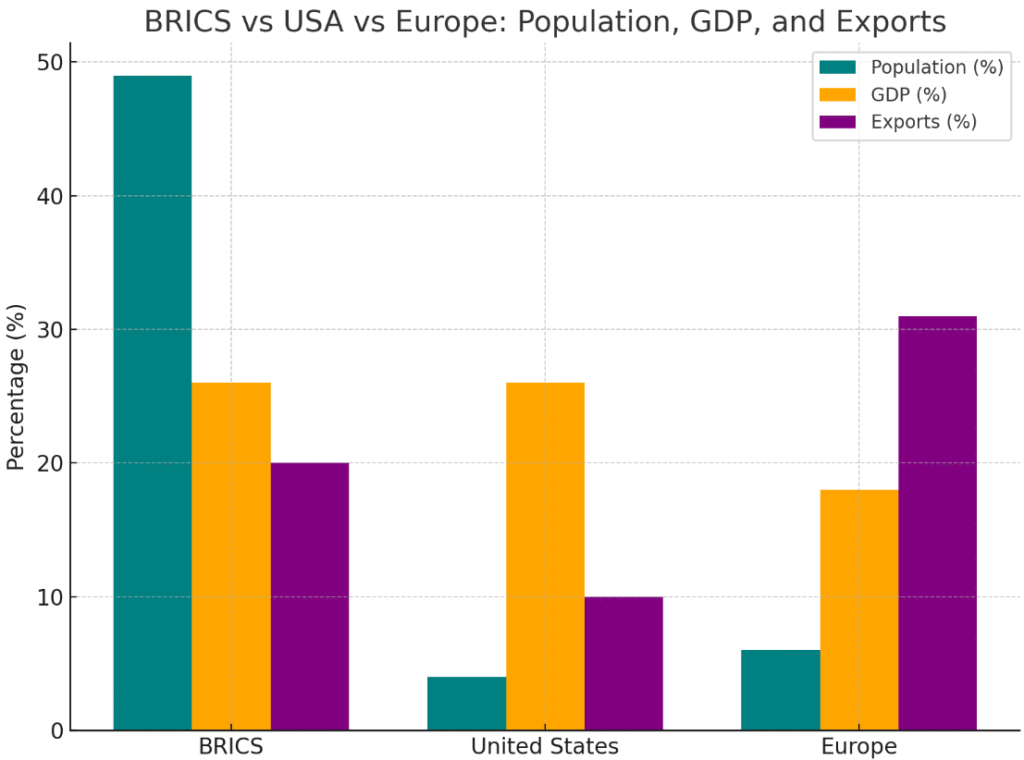The BRICS bloc—originally comprising Brazil, Russia, India, China, and South Africa—has emerged as a formidable voice for the Global South over the past two decades. Once viewed as a coalition of rising economies seeking to challenge Western dominance in global institutions, the group is now expanding its membership and influence. However, this growth is accompanied by deep divisions among its members and questions about its long-term cohesion.
A Growing Force With New Fault Lines
BRICS has expanded significantly since its inception in 2009, adding five new members in the past two years, including Egypt, Ethiopia, Iran, Saudi Arabia, and the United Arab Emirates (UAE). Indonesia joined in 2024, raising the bloc’s membership to eleven. The grouping now accounts for more than a quarter of global GDP and nearly half of the world’s population.
The 2025 BRICS summit, scheduled for July 6–7 in Rio de Janeiro under Brazil’s presidency, aims to focus on reforms in global governance and boosting South-South cooperation. Yet, the summit will take place in the absence of two major leaders—China’s President Xi Jinping and Russia’s President Vladimir Putin. Xi has cited scheduling conflicts, while Putin remains unable to travel due to an International Criminal Court (ICC) warrant related to alleged war crimes in Ukraine.
BRICS vs G7: Top Economies
Despite its influence, BRICS is often compared to the G7, the bloc of industrialized economies. The table below shows how they stack up in the Top 10 economies of the world (2025 projections):
Table 1: Top 10 Economies – G7 vs BRICS
| Rank | Country | GDP (USD Tn) | G7 Member? | BRICS Member? |
|---|---|---|---|---|
| 1 | United States | 30.50 | ✅ | – |
| 2 | China | 19.23 | – | ✅ |
| 3 | Germany | 4.74 | ✅ | – |
| 4 | India | 4.19 | – | ✅ |
| 5 | Japan | 4.19 | ✅ | – |
| 6 | United Kingdom | 3.84 | ✅ | – |
| 7 | France | 3.21 | ✅ | – |
| 8 | Italy | 2.42 | ✅ | – |
| 9 | Canada | 2.23 | ✅ | – |
| 10 | Brazil | 2.13 | – | ✅ |
G7 countries in Top 10: 7
BRICS countries in Top 10: 3
BRICS Extended in the Top 20 Economies
With BRICS Extended (adding Egypt, Ethiopia, Indonesia, Iran, UAE, and Saudi Arabia), the group’s presence in the Top 20 global economies becomes even more significant.
Table 2: Top 20 Economies – G7 vs BRICS Extended
| Rank | Country | GDP (USD Tn) | G7 Member? | BRICS Extended? |
|---|---|---|---|---|
| 1 | United States | 30.34 | ✅ | – |
| 2 | China | 19.53 | – | ✅ |
| 3 | Germany | 4.92 | ✅ | – |
| 4 | Japan | 4.39 | ✅ | – |
| 5 | India | 4.27 | – | ✅ |
| 6 | United Kingdom | 3.73 | ✅ | – |
| 7 | France | 3.28 | ✅ | – |
| 8 | Italy | 2.46 | ✅ | – |
| 9 | Canada | 2.33 | ✅ | – |
| 10 | Brazil | 2.31 | – | ✅ |
| 11 | Russia | 2.20 | – | ✅ |
| 12 | South Korea | 1.95 | – | – |
| 13 | Australia | 1.88 | – | – |
| 14 | Spain | 1.83 | – | – |
| 15 | Mexico | 1.82 | – | – |
| 16 | Indonesia | 1.49 | – | ✅ |
| 17 | Turkey | 1.46 | – | – |
| 18 | Netherlands | 1.27 | – | – |
| 19 | Saudi Arabia | 1.14 | – | ✅ |
| 20 | Switzerland | 1.00 | – | – |
G7 countries in Top 20: 7
BRICS Extended countries in Top 20: 6 (China, India, Brazil, Russia, Indonesia, Saudi Arabia).
Origins and Evolution
The term “BRIC” was first coined by economist Jim O’Neill in 2001, predicting that Brazil, Russia, India, and China would challenge the economic dominance of the G7. Russia hosted the first official BRIC summit in 2009, with South Africa joining a year later to form BRICS. The group has since sought to create alternative financial and diplomatic structures, including the New Development Bank (NDB) and the Contingent Reserve Arrangement (CRA), aiming to reduce dependence on Western-led institutions like the World Bank and IMF.
Ambitions to Challenge the Dollar
One of BRICS’ key goals has been reducing reliance on the U.S. dollar in global trade. Discussions have ranged from increasing the use of local currencies to proposals for a unified BRICS currency or cryptocurrency. However, analysts remain skeptical, citing the dollar’s entrenched role in more than 80 percent of global trade and the lack of economic convergence among BRICS members.
Internal Divisions and Rivalries
Despite shared aspirations, internal conflicts persist. China and India remain at odds over border disputes and regional influence, while the inclusion of Iran, Saudi Arabia, and the UAE risks importing Middle Eastern rivalries into the group’s dynamics. Brazil and India have been cautious about expanding the bloc, fearing a dilution of their influence and growing Chinese dominance.
Russia’s invasion of Ukraine continues to strain the bloc, with some members adopting neutral stances while others quietly support Moscow despite Western sanctions.
Western Reactions
The West has largely downplayed BRICS’ rise. The Biden administration previously dismissed the bloc as a geopolitical threat, while U.S. President Donald Trump, in a recent remark, claimed “BRICS is dead,” threatening steep tariffs on countries that attempt to undermine the dollar. European policymakers, however, warn that anti-West sentiment in the Global South is intensifying, partly due to Western failures to address the financial needs of developing nations.

- BRICS dominates population (49%) compared to the USA (4%) and Europe (6%).
- GDP is led by the USA (26%), slightly ahead of BRICS (26%), while Europe follows at 18%.
- Exports are highest in Europe (31%), with BRICS at 20% and the USA at 10%.
Looking Ahead
Brazil’s leadership of BRICS this year marks a potential pivot. While Russia steered the bloc toward an overtly anti-Western tone during its presidency, Brazil’s agenda emphasizes inclusive global governance and climate-conscious development. Still, challenges loom large, especially with major leaders absent from the upcoming summit.
Over thirty countries, including Azerbaijan, Malaysia, and Turkey, have reportedly applied to join BRICS, signaling that interest in the bloc continues to grow. Whether the coalition can overcome its internal rifts to emerge as a unified counterweight to Western power remains an open question.




